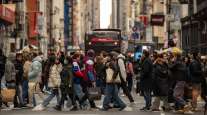Economic Growth in US Cracking Under Strain of Global Slowdown

The United States may not be immune from the global slowdown after all.
Figures on retail sales and manufacturing Jan. 15 showed the world’s largest economy ended the year on a weak note, and the start of 2016 wasn’t better. The one saving grace was a pickup in consumer confidence, but that was mainly because households believed inflation will be low, making subdued wage gains look good by comparison.
“The data this morning has been pretty much one way,” said Gennadiy Goldberg, a U.S strategist at TD Securities USA in New York. “It’s fanning some of these fears that the economy is being dragged down into the mud by the rest of the world.”
Weakness in retail sales compounds concerns that momentum in consumer spending, which has been the backstop of U.S. growth prospects, is starting to fade. Meanwhile, a slowdown in China and other emerging markets has sent commodity prices lower and roiled stock markets around the world, exacerbating the plight of manufacturers who are being hit by an appreciating dollar.
The turbulence complicates the task of Federal Reserve policymakers, who started raising interest rates last month on the expectation that U.S. growth would continue to strengthen and inflation will pick up.
Stocks extended declines Jan. 15 after the reports, with the Standard & Poor’s 500 Index falling 2.9% to 1,866.89 at 12:52 p.m. in New York, as all 10 industries retreated. The Dow Jones Industrial Average slid 473 points to 15,906.
Six of 13 major categories in the retail sales report showed declines in December from the prior month. More importantly, the figures used to calculate gross domestic product, which exclude categories such as food services, auto dealers, home-improvement stores and service stations, unexpectedly dropped 0.3%, the most since February.
The slowdown, including electronics stores, clothing merchants and grocers, indicates Americans probably preferred to sock away the savings from cheaper fuel instead of splurging during the holiday season. While hiring has been robust in recent months, faster wage gains remain elusive, one reason household purchases may take time to accelerate.
The disappointing spending data, along with reports on inventories and factory production, caused some analysts to cut their already-low forecasts for fourth-quarter GDP. Economists at Macroeconomic Advisers reduced their tracking estimate for year-end growth to a 0.4% annualized rate from a 0.5% pace. Barclays lowered its forecast to 0.3% from 0.7%, while Credit Suisse cut to 0.8% from 1%. In the third quarter, the economy expanded 2%.
Manufacturing continued to weaken last month, as demand for automobiles, which provided one of the few bright spots for the industry, comes off the boil. Output at factories dropped 0.1% for a second month, Fed figures showed.
Meanwhile, data from the Federal Reserve Bank of New York showed manufacturing’s struggles extended into 2016. The bank’s gauge of business activity in the region contracted in January at the fastest pace since March 2009.
The one bit of positive data also came with a caveat. Consumer confidence rose to the highest level in seven months, according to the University of Michigan’s preliminary sentiment index for January, though that came mainly on the back of lower inflation expectations.
Americans projected the inflation rate in the next year will be 2.4%, the lowest in the survey since September 2010. The report also showed households projected wages would climb just 1% over the next year, the weakest reading since January 2015.
Combined, that meant Americans had the most upbeat assessment of inflation-adjusted wages since January 2007, according to the Michigan survey.
St. Louis Fed President James Bullard, one of the most vocal policymakers in recent months arguing to raise interest rates, said in a speech Jan. 14 that the renewed decline in oil prices and the decrease in market-based inflation expectations measures “is becoming worrisome.”
Fed policymakers’ latest median projections issued in December implied the central bank would raise the benchmark interest rate by 1 percentage point this year. The volatility could cause officials to pass on a March hike, however. Futures markets Jan. 15 assigned a 67% chance of no change at that time, up from 57% on Jan. 11.
Another report Jan. 15 showed wholesale prices weakened in December, which may add to concerns that inflation will take longer to drift back toward the central bank’s 2% goal. A 0.2% decrease in the producer-price index followed a 0.3% gain in November, according to figures from the Labor Department. Energy costs slumped 3.4%, led by a 23.4% plunge in diesel fuel that was the biggest since 1990.
Some economists cautioned against extrapolating the year-end weakness too far, pointing to the still-strong labor market as a sign that growth remains anchored. Payrolls climbed by 2.65 million last year, capping the best two years for employment growth since 1998-1999.
“Labor market dynamics have remained extremely strong,” Harm Bandholz, chief U.S. economist at UniCredit Bank AG in New York, wrote in a note to clients. He added that the drop in oil prices, which continues to sink markets, “is unequivocally good for the consumer.”
“Admittedly, private households have thus far saved most of the windfall,” Bandholz said. “But these savings are an important buffer and fuel for ongoing strength in consumer spending going forward.”




